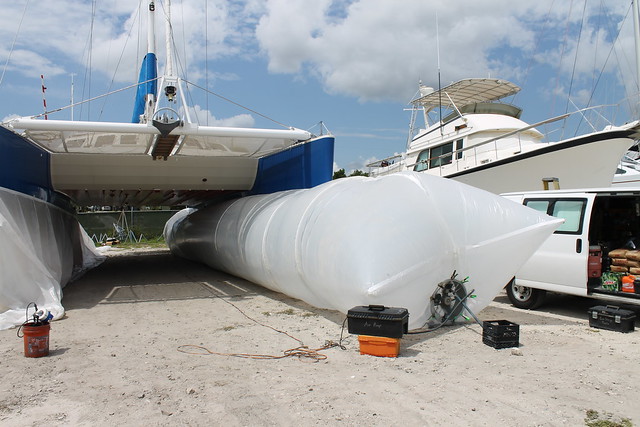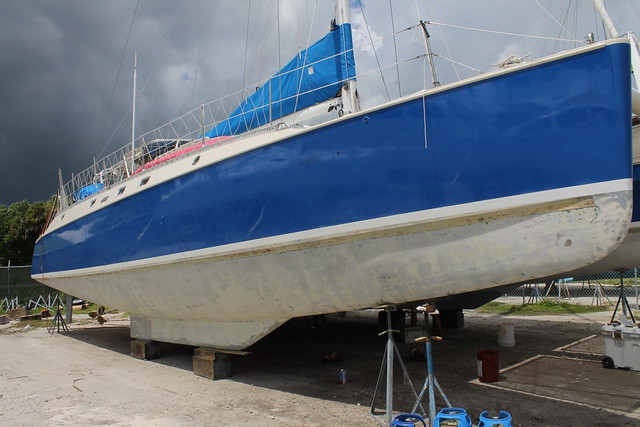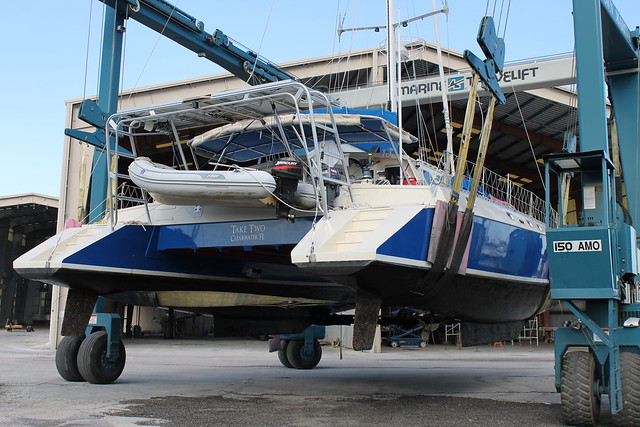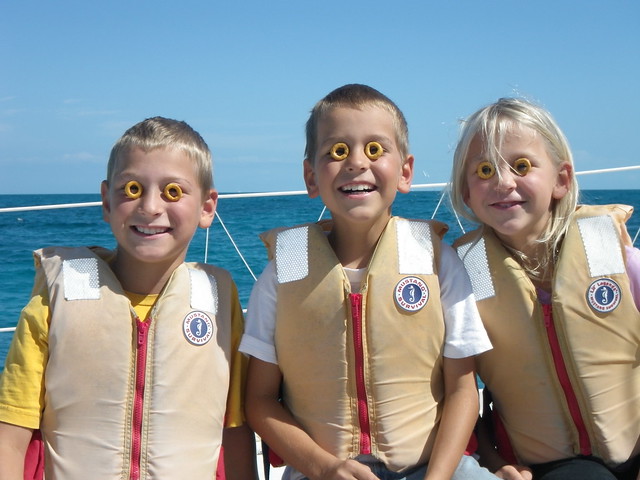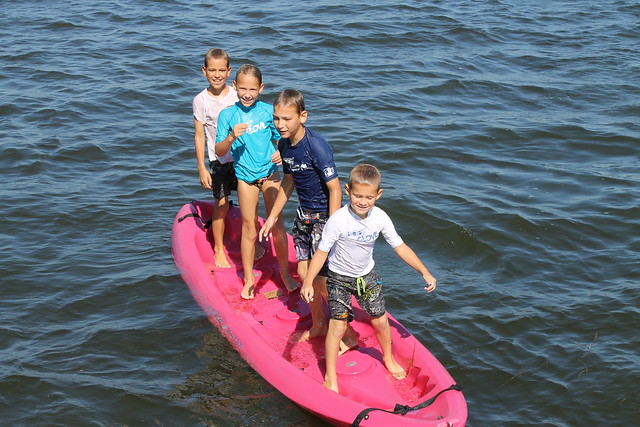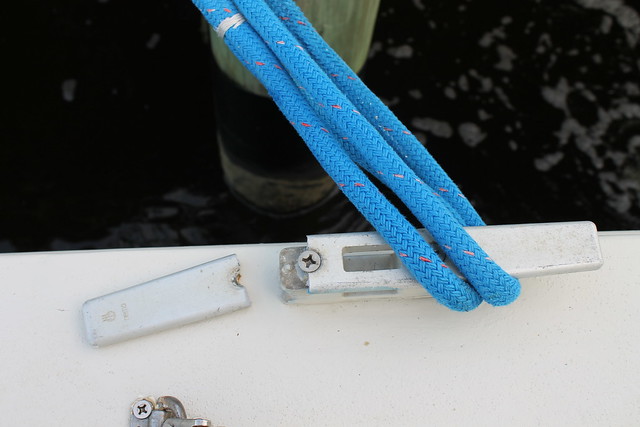We have been feeling for some time now that it is time to leave the dock. All of us are itching for adventure after working hard this past year—whether it was business travel, boat projects, schoolwork, teaching or having a baby. Finally, we looked at our sorry excuse-of-a-list, knocked off the have-tos and decided to leave. We picked our weather so that we could have an easy sail down the coast, with a familiar anchorage waiting at the end of the day, and a safe place in case the weather deteriorated (which it had a strong chance of doing). After a false start on a rainy Wednesday evening (violated Rule #1: We only set sail in fair weather), we left on a calm and quiet Thursday morning, optimistically taking dock lines with us, with no fanfare or fuss, just the way we like it.
We got out into the Gulf, only to find the wind already shifting to the South, along with swells on the nose. It was going to be a long day of motoring upwind. We looked at each other and agreed that it didn’t make sense. We hated to admit defeat, but this wasn’t going to be the day to ease us back into our old rambling lifestyle. We both had a lot of unspecified anxiety about leaving the comfort of the dock, and a long, wavy day wasn’t helping. Should we tuck tail and run back to the marina? At Aaron’s request, we decided instead to anchor in Terra Ceia Bay, not three miles from our slip, but a world away by the feel of it. We were surrounded by mangrove islands, not another boat in sight, and plenty of breathing room. We dropped the new 80-pound Manson hook with 5:1 scope (all chain) near Bird Key, because it is nice to look at, close to good mangrove tunnels and coves for exploring, and because we’d been there before. We weren’t really thinking we would be weathering storm-force winds there, or we might have anchored on the windward side of the bay, and would definitely have laid out more chain.
It was just what the doctor ordered. For two days, we swam, kayaked, and found our cruising groove—living without the A/C, power cord and water hose. Even if we had to go back, at least we left for a few days, right? And then the wind began to blow. Terra Ceia is one of our possible hurricane holes. Marinas, especially with floating docks, can be dangerous places in a storm. Aside from wind damage and boats breaking loose, the whole dock can float off the pilings with the high water of a storm surge. In a mangrove-sheltered bay, even if you break loose, the boat is not likely to sustain a lot of damage. So, even with our dubious location inside the bay, we were pretty comfortable as the wind began to climb and whitecaps began to form. I went out at one point to take some swim suits off the life lines and was pelted with raindrops driven by 40-knot winds. Ouch!
We watched weather forecasts and kept our eyes on the skies. It grew wild and wet and uncomfortable. The wind began to blow consistently 30-35 knots with gusts in the 40s. But it was exciting, too. Weathering a storm on the water has a way of making you feel very alive. As the wind shifted, we grew nervous about our proximity to the shore behind us. We used the GPS anchor alarm to make sure the anchor was holding because we didn’t want to end up in someone’s back yard. I wondered aloud if someone in one of those houses was watching us. Later that first night, we thought we saw a spot lite on the end of a dock, but didn’t think much of it.
The next morning, we had a funny email from the guy who lived on the lee shore. He had looked at our boat name, found our web site and contacted us to see if we were okay. He noted that our anchor seemed to be holding, but didn’t know if we had enough food/water for a long stay. He offered to float us a pizza if we got desperate. It was very kind, and we replied that we were fine, and were prepared for this sort of thing. The weather was unbelievable—it just blew and blew and blew, with no discernible lessening of wind or waves. How long, we wondered, could it last? We lost sleep and got cabin fever. While we waited for the storm to end, we traded emails with our new neighbor, finding out that he too had lived aboard a sailboat and cruised extensively, having survived many storms at sea.
What are the odds, I ask you? We anchor in a desperate move to avoid admitting failure, and find ourselves on a lee shore in a tropical storm, in the back yard of a world-traveler and fellow-cruiser! Life is funny like that. I stopped believing in coincidence a long time ago, but I still find myself pleasantly surprised. After the blow finally ended (day five of our unintended cruise to Terra Ceia), we dinghied over to the neighbor’s with a loaf of bread and introduced ourselves. The kids immediately started piling up tree branches that had blown all over his yard, burning off some of that pent-up energy. We ended up spending the better part of our day with our new-found friend, the kids climbing his tree, borrowing his canoe to go on an explore, and crabbing along his sea wall. They were as happy as clams, and we were glad to be ashore in the fine sunshine and gentle breeze and swap stories with an old salt.
We had reached decision time. Looking at the calendar and the weather, we had to decide whether we had time to get anywhere new before Jay had to be on location for a new project. Our trip to the Dry Tortugas was looking impossible (violated rule #2: We don’t sail on a schedule), but did going back to our slip serve our new goals? Did we even have any new goals? We did what we set out to do this past year: have a baby and refit the boat. But what’s next for us? We were reminded this week why we like cruising, and why we bought a boat in the first place. We managed to break out of the marina, and we don’t really want to get comfortable with a land-based life or feel tied-down. We will never be totally ready and the boat will never be finished, so we just have to pick an arbitrary date and go.
So we went, with a tentative destination, but not really knowing what the future holds. But then, do we ever? And isn't that part of the charm of a roving lifestyle? At least surviving the storm cured us of, or inured us to, our jitters. We left and felt good about it. What a difference a week’s adventures can make.

